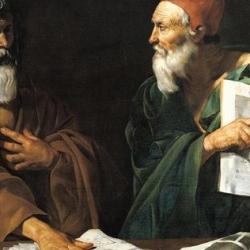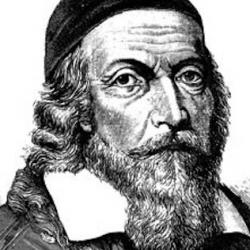Rosenstock-Huessy’s brief essay on Descartes (included in I Am An Impure Thinker, extracted from Out of Revolution) highlights a number of recurring themes in Rosenstock-Huessy’s work: He discusses his own formula, Respondeo etsi mutabor, in contrast to the cogito of Descartes; he attacks the abstractions of science and modern thought; he distinguishes between names and words; he proposes a temporal alternative to the subject/object dualism. Throughout, his historicism is in full view – that is, he recognizes the important and legitimacy of Descartes in his time, but says that we are in new times that demand we say “farewell to Descartes.”
For Rosenstock-Huessy, Descartes’s importance lies in the fact that he laid “the rational foundations of modern science.” The cogito is not, on his view, merely an effort to secure epistemological certainty, but the basis for the “programme of man’s scientific conquest of nature.” He explains in part how this is so in a paper on the “Quadrilateral of Human Logic,” also included in Impure Thinker. The cogito separates the human subject from the world of objects. And, bound as it is with Descartes’s notion that man is a “thinking thing,” it implies that human beings are “things” rather than persons. A thing, Rosenstock-Huessy says, is spoken about, not spoken to. In a single formula, Descartes both reduced human subjectivity to “thingness” and declared that the relationship between man and the world to be one of mastery.
In “Farewell to Descartes” itself, he places the cogito in a historical sequence of formulae. Anselm’s “credo ut intelligam” declares that “truth is divine and has been divinely revealed”; Descartes’s formulate says that “Truth is pure and can be scientifically stated”; and Rosenstock-Huessy’s own formula states that “Truth is vital and must be socially represented.” In a post-World War I situation, it is impossible to continue with Descartes because Cartesian “purity” “encroaches everywhere on the field of social studies.” Rosenstock-Huessy revels in his impurity: “I am hurt, swayed, shaken, elated, disillusioned, shocked, comforted, and I have to transmit my mental experiences lest I die.” He is not engaged in a detached, “pure” intellectual exercise. Vulnerable, he is plunged into life, with all its obstacles, frustrations, and pains.
Modern science, following Descartes’s pursuit of purity, highlights physics with its “abstract” and mathematical figures (rather than biology). Modern philosophy aims to formulate “general ideas” in metaphysics. Both are obsessed with the dead: “Neither from the laws of gravity nor from the ideas of logic or ethics is there any bridge to lead into the realms of life, be it the life of plants and animals or of human society. Dead things are forever divided from the living; figures and ideas belong to the limbo of unreality.” Despite the variations within modern thought, all assumed that “scientific thought should proceed from the simple facts of physics or general ideas,” and that on this foundation they could build all the other sciences. Once this is exposed as “fallacy,” it becomes clear that “Marx [is] as much the on of a bygone era as Descartes or Hume or Hobbes.”
Cartesianism and its offspring in philosophy and science are wrong at the foundation. To understand life and society, one cannot start with “thought” or “being,” with mind and body. Instead of providing foundations, physics and metaphysics should come last: “physics has to do solely with an extreme case in nature, its most remote appearance. Therefore, physics can more fittingly be described as the last chapter of biology than as the first chapter of natural science.” The names of the sciences of the modern world end in “-ology,” highlighting the fact that they are concerned with abstract “words.” By contrast, Rosenstock-Huessy proposes a structure for science organized around names, a set of “-nomics” rather than a set of “-ologies.”
Yet, Rosenstock-Huessy is not blind to the achievements of Cartesian science. The cogito “invited us all to join the army of research in its fight against irrational nature.” The George Washington Bridge and Lindberg’s flight across the Atlantic are two signs of the greatness of the cogito’s achievement, which “deserves our lasting support.”
The Cartesian formula is useful to some degree in our dealings with nature. It is useless in human life. The problem with Descartes is that “the reality that confronts the bionomist and economist cannot be divided into subject and object.” This is not even scientifically defensible, he claims, since subjectivity has been discovered in “every living object that comes under the microscope.” Every “object” of nature is an Ego,” and this means that “the whole nomenclature of subject and object is revealed as ambiguous and useless for any practical purpose.” Nor is the subject/object dichotomy useful for understanding human life: “Whoever acted as a mere subject or a mere body? The Ego and the It are limiting concepts, luckily seldom encountered in vital reality.” Man becomes object only when reduced to “hands” or “cogs in a machine.” With physics in the driver’s seat, and man treated as an It, modern society has become “mechanistic” and “wrong.” Cartesianism leads to tyranny: “An imagination which could divide the world into subject and object, mind and matter, will not only accept the cog in the machine with perfect equanimity, but will shrink even less from the cold skepticism of the intellectual.”
Neither Ego nor It names an actual human being: Both are “deadening caricatures of man’s true location in society.” In their extreme forms, they are “pathological” cases. A man can be pressed in one or the other direction, but this leads to a twisted humanity, and man never becomes completely Ego or It: “Though man tends to become an Ego and is pressed by his environment to behave like an It, he never is what these tendencies try to make of him. A man so pressed into behaviorism by awkward circumstances that he reacts like matter, is dead. A man so completely self-centred that he is constantly behaving as the sovereign Ego, runs insane.” A world of Egos leads to war; a society full of cogs produces anarchy. Soul is neither, but “veers” between Ego and It.
A dualism runs throughout every human life. Man is man in the “middle voice” between subject and object. (This formula points to the large contrast Rosenstock-Huessy often draws between Nature and soul.) But the dualism is not to be conceived “spatially” but temporally, not as subject/object but as traject/preject.” By “traject,” Rosenstock-Huessy means that we follow the traditional flow of our civilization, “sitting in its boat of peaceful evolution.” But that only works when society has direction. Once it stalls and loses direction, we have to build a new vessel and find a new direction. This is a revolutionary situation, the situation of the preject. These two imperatives – to move into the future in the boat of civilization or to construct a new boat – are “our social imperatives.” The “interplay” of traject and preject is “the problem of the social sciences.”
Rosenstock-Huessy means the grammatical reference of “middle voice” quite literally: “A new
social grammar lies behind all the successful twentieth century attempts in the social sciences.” Even the manner of teaching grammar assumes and implies a psychology, a vision of the soul. Putting all the tenses and moods into a single table sets, he says, “the keystone into the arch of the wrong psychology” because it treats all persons and forms and moods as interchangeable. Instead, as he often argues, the imperative is the “first form and the permanent form under which a man can recognize himself and the unity of his existence.” The imperative is the mood of faith, which calls us to act. This is the basis of society: “We grow into society on faith, listening to all kinds of human imperatives.” Later on, we may learn to “stammer and stutter” to explain and justify our response to that call. But the response must precede the justification, or society will be stillborn.
This is the center of Rosenstock-Huessy’s alternative formulation, “Respondeo etsi mutabor” – I respond, though I will be changed. Descartes’s formula assumes that “the same subject that asks a question and raises a doubt solves the problem.” While this may happen in physics, in any “vital” question, the question and answer are “widely separated.” Problems are put to us by circumstances, in revolutionary, emergency situations. Those problems are not our own creation, and our answers may well be merely temporary. The questions are put to us, not raised in our own mind; we are addressed from the outside. And always “we are children of time and the emergency of the day is upon us before we can rise to solve it.” In short, “the responsibility of inventing questions odes not rest on the living soul.” Questions and riddles “are put before us not by our own curiosity. They fall upon us out of the blue sky.”
Rosenstock-Huessy draws some intriguing political conclusions. Governing classes, as well as the governed, are addressees, not merely commanding but questioned and probed by circumstances, by God: “No governing class ever survives as a mere self-asserting Ego. It will always survive by responding to its original claim as God’s ‘you.’” Every revolution forces society to acknowledge that it is address: “Society shifted from an unsupportable dualism of haughty Ego and suppressed It into its proper place as God’s addressee at the point of outbreak of every great revolution.” When “a province of Christianity was denied its own proper voice,” a new “psychic type” responded and answered the question.
Seen in a larger perspective, the cogito is not opposed to the Respondeo, but a version of that imperative appropriate to a given historical period. It was “most useful when man’s path opened up into the co-operative discourse of nature.” The cogito established “distance” from nature, and that helped men to “overcome their natural weaknesses and to remove them far enough away from the world that had to be objectified.” Even Cartesian doubt has its use. The phase of thought where we know “nothing but our thought” is essential to the development of science. Descartes was in a sense building on the scholastic heritage. Scholasticism had liberated Europe from “local myths,” and this created a kind of distance within the thinking process, the distance between impression and reality. Descartes established a second distance of subjects and objects. And this scholastic distance assumed the prior distance between God and man in knowledge – embodied in Anselm’s formula.
Summarizing, Rosenstock-Huessy says that “In Anselm’s statement the emphasis is on the hearing, as the organ for inspiration by truth. In Cartesius’, it is on the doubting as the organ for transformation of this divine truth into human knowledge. In our phrasing, the emphasis shifts once more, and now to the process of making know, of speaking out at the right time, in the right place, as the proper social representation. Distance of teacher and student is necessary for learning.
But it cannot be applied to society without damage: “Neither the centuries that prepared and finally produced Descartes nor we post-War people can found our common international and interdenominational efforts on a formula that says nothing about the dignity of impressions, of learning and teaching, or listening and speaking to our fellowman.”













